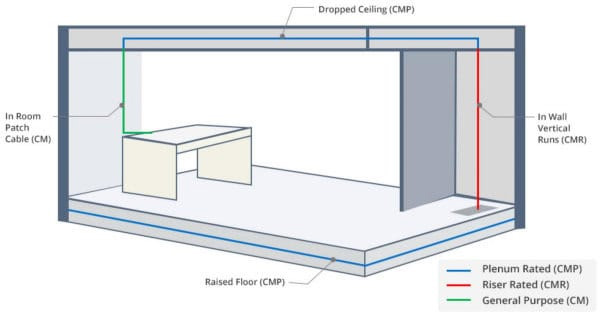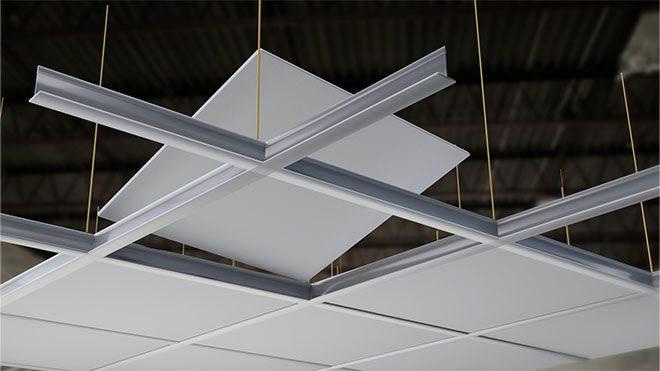What are Suspended Ceilings?
What is a suspended ceiling?
Request A free Quote Today!

Concealed duct
Concealed duct is practical gold for services coordinators. It neatly hides ductwork, cable trays, data and power cabling, sprinklers, pipework, acoustic insulation and bracing, along with steel framing or other components best kept out of sight.
It also makes it easier to add, move or service equipment over the life of the building without disturbing the finished space below.
Most suspended ceilings use two core parts to build out the plenum:
Ceiling grid: a light metal framework hung from the structure to support the finish.
Ceiling panels or ceiling tiles: removable or semi‑permanent panels seated in the grid.
Common tile materials used for suspended ceilings in NZ
Design options are broad, with panels available in mineral fibre, metal (aluminium/steel), vinyl‑faced, fibreglass, timber, or engineered acoustic substrates.
Many mineral fibre and fibreglass options deliver strong sound absorption; metal and timber bring durability, hygiene or biophilic warmth, and can be engineered with perforations and acoustic backers for performance.
Note: Other names for suspended ceilings include drop ceiling and false ceiling – at Above Board our services use the term Suspended Ceiling.

What materials can I use in a suspended ceiling?
From a materials perspective, you can specify for acoustics, aesthetics, hygiene, moisture, or fire performance:
Mineral fibre tiles: excellent all‑rounders; strong absorption for open offices, classrooms and healthcare.
Metal tiles: durable, easy to clean, ideal for healthcare/food settings; can be micro‑perforated with acoustic scrim.
Vinyl‑faced gypsum: wipeable surfaces for retail or back‑of‑house.
Fibreglass tiles: high noise reduction options for tough acoustic targets.
Timber / laminate: warm finish with concealed or expressed perforations for tuned acoustics.
Specialty acoustic polyester: design flexibility with strong absorption.
Across Aotearoa we’re seeing more metal and timber ceiling features alongside the traditional mineral fibre tile, often to support human‑centred and biophilic design while maintaining acoustic comfort.
Are suspended ceilings safe (and compliant) in New Zealand?
In New Zealand, suspended ceilings should be designed/installed to AS/NZS 2785:2020 suspended ceilings design & installation standard. This standard sets minimum requirements for design, installation and testing.
Suspension grids and tiles are parts and components under NZS 1170.5. For code of compliance under NZ Building Code clause B1 (Structure), designers reference NZS 1170.5 via B1/VM1 and apply appropriate restraints and bracing.
Where building services ducts, pipework, cable trays share the ceiling space, NZS 4219 provides requirements for the seismic performance and restraint of those engineering systems. Coordination with the ceiling designer is critical to keep clearances and bracing consistent.
Industry guidance from AWCI NZ and BRANZ also emphasises good practice for seismic restraint, services coordination and edge conditions to reduce damage and maintain life safety during earthquakes.
How do you improve acoustic performance in a suspended ceiling?
Suspended ceilings are one of the most cost‑effective ways to reduce echo and control sound transfer:
Choose absorptive tiles to lift NRC and reduce reverberation.
Perforate metal or timber panels and add acoustic scrim, backing to blend aesthetics with absorption.
Add insulation above the ceiling line to further reduce noise transfer between rooms and floors.
Use isolation clips or resilient hangers to reduce vibration paths where needed.
What are the advantages of a suspended ceiling?
Cleaner aesthetics: hides services and creates a crisp plane.
Serviceability: removable tiles grant easy access to the plenum for maintenance.
Acoustic comfort: reduces echo and improves speech intelligibility.
Energy efficiency: lowers the volume of air to condition by dropping the ceiling height.
Flexibility: swap tiles for lighting upgrades, sensors, or future services.
Compliance options: fire‑rated, moisture‑resistant and hygiene‑focused products are available for councils and insurers.
Where are suspended ceilings used?
Residential renovations and new builds: for tidier services, flat planes and improved warmth.
Office, retail & hospitality fit‑outs: flexible layouts with easy access to cabling and lighting.
Healthcare & aged care: hygiene and serviceability with sealed or wipeable finishes.
Education & industry: robust grids, acoustic control and simple maintenance.
Why Above Board Interiors?
We design, supply and install suspended ceilings across Auckland, integrating grid and tile systems, lighting layouts and services co‑ordination with our GIB® fixing team and GIB® stopping and interior plastering specialists delivering seamless, paint‑ready finishes.
Call 021 446 716 or request a free consultation.
FAQs
Are suspended ceilings compliant with NZ codes?
Yes, when designed and installed in accordance with AS/NZS 2785:2020 and engineered for seismic actions under NZS 1170.5, suspended ceilings are a proven, compliant solution.
How do I improve sound control?
Combine high‑NRC ceiling tiles or perforated metal or timber with acoustic backing to absorb reflections, add insulation in the duct to limit noise transfer, and use baffles or rafts in key zones.
Are there moisture‑ or fire‑rated options?
Yes, we specify moisture‑resistant tiles and components for bathrooms and kitchens, and select tested fire‑rated systems or finishes to meet project compliance requirements.
How long does the installation take?
Programme depends on area, penetrations, service density and lead times, but once set‑out is complete and services are co‑ordinated, small office areas can be turned around quickly. We normally confirm a project‑specific programme after site review and drawings.
